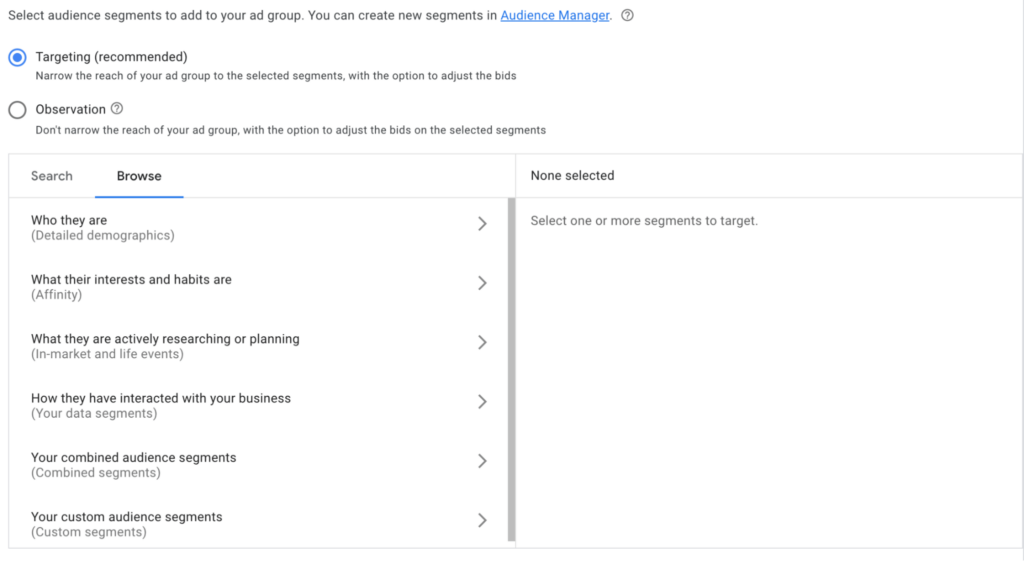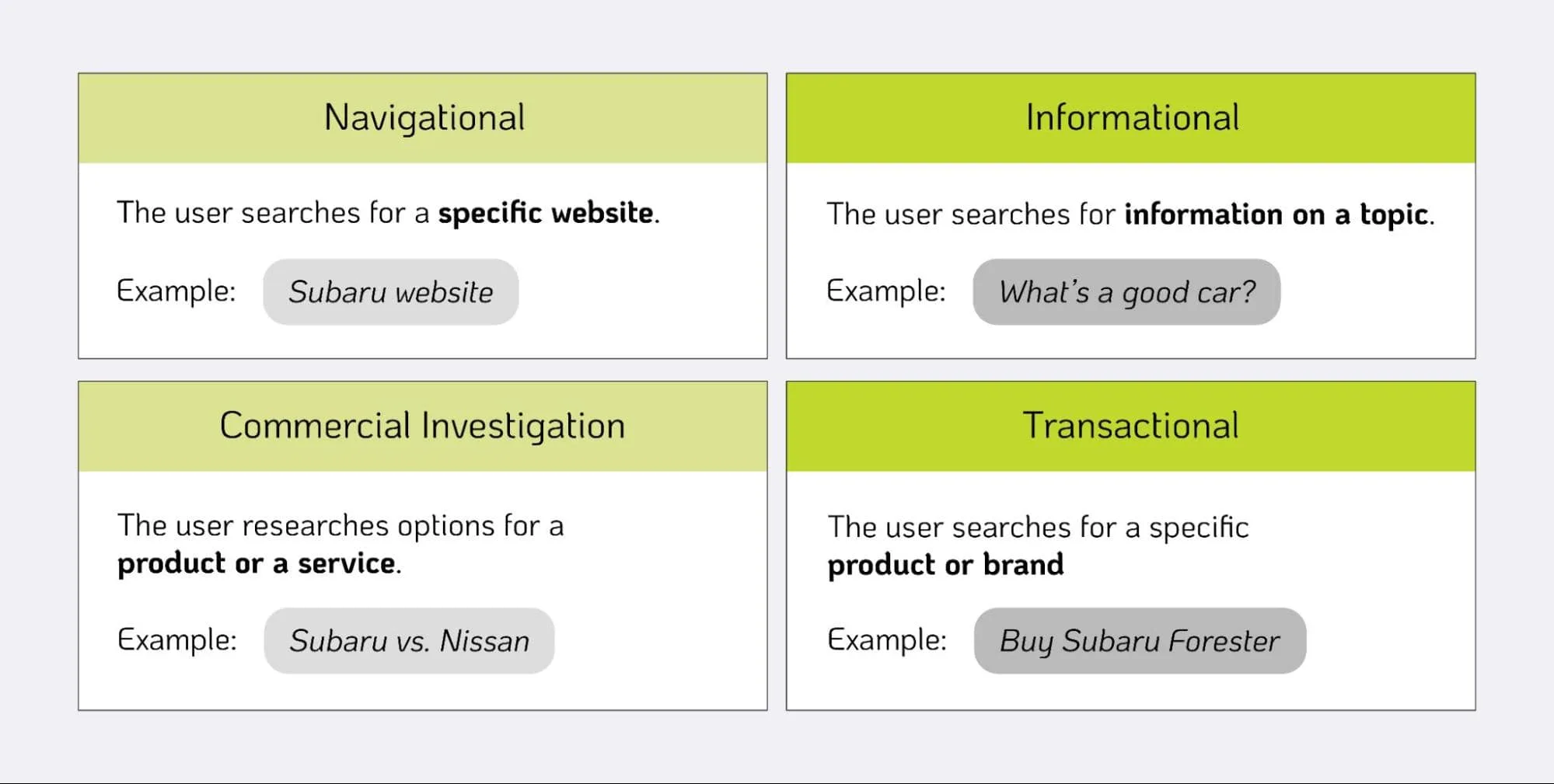How to Correctly Identify Your Google Ads Audience and Better Target Your Consumers
- Marketing Strategy
- PPC: Paid Advertising

Unfortunately, there isn’t a universal roadmap to achieve a successful marketing campaign. And it can be frustrating to put the work in, and the budget, and ultimately not see the results you deserve.
We’ve seen this frustration happen time and time again. Which is why we’ve written this blog. We’ll outline the logistics behind Google Ads audiences, and our best practices when it comes to getting to know your audience better.
What is the Google Ads Platform?
We are going to be talking a lot about Google Ads Audiences, and to start the conversation, it’s important to have an understanding of the Google Ads Platform. Feel free to start exploring the platform and get some hands-on experience.
Within the Google Ads platform, you can obtain resources and valuable insights into the different aspects, including your google ads audiences of choice. There are a multitude of tools to help you find keywords, reach new and existing audiences, and test different strategies.
Breaking Down Google Ads Audience Segments
There are multiple types of audience segments you can create in Google Ads. But we’re going to focus on Google Ads’ in-market audiences, affinity segment targeting, and custom segments.
By utilizing these three types of audience segments, you can capture users who are highly invested in your company or product and users who are in the beginning stages of the buying journey.
- Affinity Segments. If you’re creating a brand new audience or starting from scratch, affinity segment targeting is a great way to capture users in the beginning stages of the consumer journey.
This type of Google Ads audience emphasizes a user’s interests, rather than their recent spending habits. We recommend using affinity segment targeting to raise brand awareness and reach new users. - In-Market Segments. Going a bit deeper into the funnel, Google Ads’ in-market segments capture users based on recent purchases or ones with transactional intent. This is a great Google Ads audience to take advantage of when you have a clear understanding of your users and what they want from you.
- Custom Segments. Google Ads’ custom intent audiences allow you to get very specific with your audience and target users based on keywords and URLs. This type of Google Ads audience comes with time and is especially useful once you have success with the platform.
So let’s say you’re a home improvement company but you want to focus a specific ad on kitchen repairs. You can include distinct keywords related to this topic. You can also include different URLS that are relevant and have information on kitchen repairs.
Building Your Google Ads Audience
As you begin building your Google Ads audience, you’ll first have to decide between “observation” and “targeting.”

- Observation. Google will observe how certain criteria perform within your ads without limiting the reach of your ads. Essentially, it’s going to watch how the ad performs and better the audience/ad based on these observations.
We recommend using the observation feature for building newer audiences and any Search or Display campaigns.
- Targeting. On the other hand, targeting is going to put you in control of who sees your ad and where it’s shown. Just like Google custom intent audiences, this is for specific audiences and specific content.
We’d recommend using targeting once you have a solidified understanding of who your audience is and are looking to capture users who are further into the consumer journey.
Once you’ve chosen observation or targeting, the next step to building your Google Ads audience is to include demographics. You can choose between a wide variety of segments, including age, location, and household income.
You may also decide to set up exclusions in your audience. Just like in social media advertising, exclusions are important to incorporate so your ads aren’t shown to people who are unlikely to interact with your product or service.
Pro Tip: We encourage you to connect your Google Ads and your Google Analytics 4 accounts so you can get a full picture of your customer’s journey. This connection allows you to better understand conversions and events happening from users interacting with your Google ads.
Who Are You Targeting?
Now that we’ve laid out how to logistically set up your audience, it’s time to outline how to decide who’s best to target and how you can access a more in-depth understanding of your audience.

Look At the Stages in the User/Buyer Journey
There are five stages in the user/buyer journey, but we’re going to focus on the following three: awareness, consideration, and decision. If your marketing budget allows for it, you should be creating separate ads for users in each of these consumer stages.
- Awareness Stage. When a user is in this stage, they’re browsing for general ideas, products, and services to help them solve a problem. They aren’t at the stage where they want to make any purchases. They’re simply gathering information.
Google search queries in this stage are going to be more general, like “best running sneakers” or “new garage door.” - Consideration Stage. Moving down the funnel a little, users in the consideration stage are going to start getting a bit more specific and finding a solution to their problem. In the awareness stage, they were looking for a change, but in the consideration stage, they’re looking for a solution.
Search queries could include “best shoe stores near me” or “should a professional install my new garage door.” - Decision Stage. The last stage of the user buying journey is where someone is going to be very intentional about their searches because they’re looking to make a purchase. They’ve done the research and know what product or service will solve their issue.
Google search queries are going to be specific like “HOKA shoes for running marathons” or “real-wood overhead garage doors.”
Your goal should be to capture users at every stage of the buying journey. Which means finding relevant and valuable keywords and language that matches each step of the process. Not sure how to find the right keywords for your ads? Don’t worry, we’ll get into that now.
Consider the Intent of Your Audience
Within each stage of the user/buyer journey, there are different intents for the consumer. You should recognize each intent so you can create a specific ad targeting their needs or wants.

There are four different types of intent keywords. They are information, navigational, commercial, and transactional. By getting a grasp of each of these, you can create different audiences for each consumer stage.
A general rule of thumb is as follows.
- Information intent keywords are going to target users in the awareness stage.
- Navigational and commercial intent keywords are geared toward users in the consideration stage.
- Transactional intent keywords capture users in the decision stage.
Now, you can combine keyword groupings and reach multiple stages at once within your ad campaign. But, the language would have to be fairly general in order to attract all three stages.
This is why we recommend focusing on one stage per campaign with your keywords, language, and targeting so you can make each ad more personable for the user.
Tips to Knowing Your Audience Better
It’s easier said than done to know who your audience is and to craft ads that target specific segments. But we’ll outline some of our best tips so you can feel confident that you’re getting to know your audience and giving them information they engage with.
Do Your Research
First and foremost, do as much research with the tools you already have. Within your Google Analytics 4 account look at engagement metrics and see what users are doing on your site. If you have a page that’s getting a lot of traffic and conversions, you can continue this momentum by creating a supporting Google Ad.
You may be surprised to see how much insight you can also get by talking to your leadership, sales team, and marketing team.
- Is the sales team noticing a product or service that’s selling really well?
- What initiatives is your marketing team taking that you can support through Google ads?
- Are there blogs already written on topics you can advertise?
- Are there specific goals your leadership would like to see achieved this year?
By involving these departments in your marketing blueprint, you can ultimately create a comprehensive and well-rounded strategy.
Also, look at what your competitors are doing! They could spark ideas for advertising topics or landing pages. See what they’re doing and how you can put your unique value proposition into it to capture your audience’s attention.
Create a Target Persona
You benefit greatly from creating a target persona for every stage of the user funnel. What are the characteristics of someone in the awareness stage, or the consideration stage? How will the language of these ads differ from someone in the decision stage?
By having a clear outline of each stage and a target persona, you can truly start to craft specific language for each consumer stage. These personas also help you narrow down what your targeted users are searching for.
A lot of times businesses focus on their brand voice and tone when really they should be focusing on what customers are searching for on Google.
Do Some A/B Testing
By testing different Google detailed demographics, intent keywords, and audiences you can get a full picture of what people are responding to and what’s working well (or not working well) with your advertisements.
When you’re testing different characteristics, make sure you’re not changing everything at once. In fact, we recommend only changing one thing at a time so you have a concrete idea of whether the different feature benefited your ad or not.
Find the Right Keywords
We talk a lot about using intent keywords in your SEO and content marketing strategies, but you can also take full advantage of them within your Google ads. Especially when using Google’s custom intent audiences.
As we mentioned above, there are four different types of intent keywords. By utilizing and grouping these together, you can create audiences that attract a user from any stage of the consumer journey.
We recommend using the Keyword Magic Tool from SEMrush as a great start to finding relevant and valuable keywords for your campaigns!
Additional Tools
Here are a few additional resources our team uses to find the best insights for a great Google Ads audience.
- Organic Insights in SEMrush. You can see keywords, landing pages, users, and conversion insights within this tool. See where your audience is going, what pages they are most interested in, and topics that are sparking their attention.
You can also see where your competitors are ranking well and what topics they are advertising. Ultimately, this is a great tool to connect your SEO and content strategies with your Google Ads campaigns. - Google Trends. This is a great starting point to find trending topics or see specific keywords and how they trend over time. Maybe you have a seasonality factor to strategize for and you notice there’s a trending topic in the spring that you should be targeting.
- Microsoft Clarity. Our SEM team uses this tool to see where our audiences are going when they land on the site and what pages are gaining the most traffic. It can also help you see what CTAs and buttons are working really well on your page which can then be mirrored in your Google Ads.
Get in front of the right people and reach new users by utilizing Google Ads audiences. Have questions about how to get started? Our PPC specialists are here to help!
This blog was originally published on June 16, 2021, and was updated on August 1, 2023.
 By Sierra
By Sierra  Lauren
Lauren  Trevor
Trevor